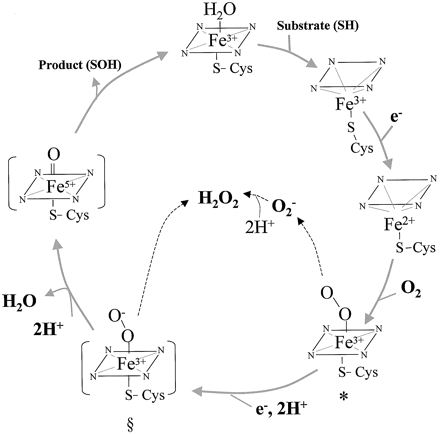Overview
Cytochrome P450 3A4 (CYP3A4) is in the heme-thiolate monooxygenase enzyme family meaning the protein contains a heme group with an iron atom. Enzymes in Cytochrome P450 are oxidizing enzymes and CYP3A4 works in the body oxidizing foreign molecules such as toxins and drugs[1][2]. It appears almost half of the marketed pharmaceutical drugs are metabolized by CYP3A4 [1] All Cytochrome P450 are essential enzymes for metabolism and the enzyme CYP3A4 is the most important. [2] Primarily found in the liver and intestine, CYP3A4 is localized in the endoplasmic reticulum membrane [3] and are present in all eukaryotic organisms as well as some prokaryotes[3]. While CYP3A4's role in drug metabolism are numerous, they are often aiding deactivation through facilitated excretion from the system or by direct inactivation. [4]
Mechanism
Because water molecules are stripped away when substrate binds, this causes an entropy change of 26 kcal/mol. This entropy driven reaction has a spontaneous free energy change of -7.7kcal/mol at 21ºC [4].
The cycle begins with the binding of the substrate to the ferric heme. With the addition of an electron, the heme gets reduced. This can only happen once the substrate is bound because the reduction potential is -300V which is more electronegative. After substrate binding, the induced conformational shift causes the reduction potential to be more positive at -230V making this a more thermodynamically favorable reaction. Oxygen next binds to the heme and oxidizes the iron. The addition of a second electron cleaves the oxygen-oxygen bond allowing one atom to bind two protons producing water. The second oxygen joins the substrate in what is called a monoxygenation reaction [5].

Structure and Sequence
The gene encoding CYP3A4 is located on chromosome 7 in the human genome[6] and it has been found that there are significant variants of the protein correlating to race [7]. This finding is relevant due to the proteins altered ability to react with substrates such as testosterone [8].
The can be seen colored in rainbow succession from the N to C terminus. The protein pocket, where the reactions are catalyzed, more specifically, the contains twenty-two residues [5] but the main interaction is with a Cysteine at position 442, which coordinates with iron. [6].
Drug Metabolism
CYP3A4 is thought to affect the metabolism of 30-60% of the drugs on the market [7] [8]. An orally prescribed drug can take a while to arrive at its target cell and along the way the body has enzymes that filter out the drug dampening its efficacy. Of those enzymes, CYP3A4 is a main player and still a lot more needs to be learned. In many cases, like that of the ß2 receptor, there is only a fraction of the drug remaining after what is known as the first-pass metabolism so that by the time the drug gets to the circulatory system where it can be delivered to the tissues its potency has already been compromised [9].
One way to work around this is by intravenous administration so as to bypass the biological filters of the gut and go right into the bloodstream.



